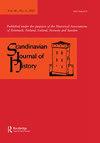丹麦外交政策激进主义的开端:1990-1991年支持波罗的海独立
IF 0.8
3区 历史学
Q1 HISTORY
引用次数: 0
摘要
1990年至1991年,丹麦的外交政策发生了明显变化,特别是对波罗的海国家的外交政策,从不承认苏联占领波罗的海国家的沉默政策转变为积极支持波罗的海国家的独立。根据解密文件,本文认为,尽管苏联的衰落和美国对丹麦新立场的认可和支持使这种转变成为可能,但最终驱动这种转变的是丹麦外交政策中普遍存在的一种想法,即这将进一步促进丹麦的长期间接安全利益。通过帮助恢复波罗的海另一边的三个民主小国的独立,丹麦可以促进一个更稳定的波罗的海地区- -对丹麦来说威胁更小。政策转变的其他假设是:丹麦希望加入波罗的海事业,是为美国提供有益服务的一种方式;或者它是由“纯粹的”人道主义动机驱动的,或者是出于对国际和国内声望的考虑,这些都被审查和拒绝了。本文章由计算机程序翻译,如有差异,请以英文原文为准。
The beginnings of Danish foreign policy activism: Supporting Baltic independence 1990-1991
ABSTRACT 1990–1991 saw a distinct change in Danish foreign policy in general and towards the Baltic countries in particular, shifting from a quiescent policy of non-recognition of the Soviet occupation of the Baltic countries to active support for Baltic independence. Drawing on declassified documents, this article argues that although the shift was made possible by Soviet decline and by US approval and support for the new Danish position, it was ultimately driven by the idea prevalent in Danish foreign policy thinking that it would further Denmark’s long-term indirect security interests. By contributing to restoring the independence of three small democratic states on the other side of the Baltic Sea, Denmark could promote a more stable – and to Denmark less threatening – Baltic Sea area. Alternative hypotheses for the shift in policy: that the Danish desire to adopt the Baltic cause was a way to perform a useful service to the US; or that it was driven by ‘pure’ humanitarian motives, and/or by consideration for international and domestic prestige are examined and rejected.
求助全文
通过发布文献求助,成功后即可免费获取论文全文。
去求助
来源期刊

SCANDINAVIAN JOURNAL OF HISTORY
HISTORY-
CiteScore
1.10
自引率
20.00%
发文量
33
期刊介绍:
Scandinavian Journal of History presents articles on Scandinavian history and review essays surveying themes in recent Scandinavian historical research. It concentrates on perspectives of national historical particularities and important long-term and short-term developments. The editorial policy gives particular priority to Scandinavian topics and to efforts of placing Scandinavian developments into a larger context. Studies explicitly comparing Scandinavian processes and phenomena to those in other parts of the world are therefore regarded as particularly important. In addition to publishing articles and review essays, the journal includes short book reviews. Review essay proposals and polemical communications are welcomed.
 求助内容:
求助内容: 应助结果提醒方式:
应助结果提醒方式:


